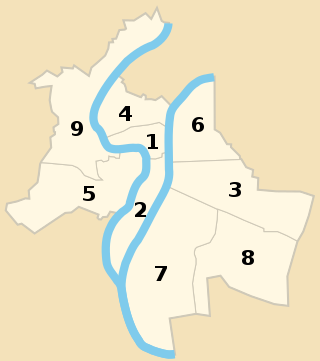
The nine arrondissements of Lyon are the administrative divisions of the City of Lyon. Unlike the spiral pattern of the arrondissements of Paris, or the meandering pattern of those in Marseille, the layout in Lyon is more idiosyncratic. This is for historical reasons: following the annexation of the communes of La Guillotière, La Croix-Rousse and Vaise in 1852, the newly enlarged city was divided into 5 arrondissements, which originally spiralled out anticlockwise from the Hôtel de Ville ; however, as the city's population expanded, it became necessary to split certain arrondissements, giving rise to today's seemingly random pattern.

Lyon, also spelled in English as Lyons, is the third-largest city of France. It is located at the confluence of the rivers Rhône and Saône, to the northwest of the French Alps, 391 km (243 mi) southeast of Paris, 278 km (173 mi) north of Marseille, 113 km (70 mi) southwest of Geneva, 50 km (31 mi) northeast of Saint-Étienne.

The Parc de la Tête d'or is a large urban park in Lyon, France, with an area of approximately 117 hectares. Located in the northern part of the 6th arrondissement, it features the Jardin botanique de Lyon, as well as a lake on which boating takes place during the summer months. Due to the relatively small number of other parks in Lyon, it receives a huge number of visitors over summer; it is a frequent destination for joggers and cyclists.

The 1st arrondissement of Lyon, France is one of the nine arrondissements of the City of Lyon. It is located below the hill of Croix-Rousse and on the north part of the Presqu'île formed by the Saône and the Rhône, the two rivers in Lyon.
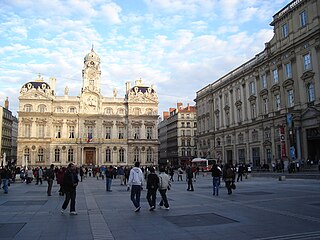
The Place des Terreaux is a square located in the centre of Lyon, France, on the Presqu'île between the Rhône and the Saône rivers, at the foot of the hill of La Croix-Rousse in the 1st arrondissement. It borders both the Hôtel de Ville and Musée des Beaux-Arts de Lyon. The square belongs to the zone classified as a World Heritage Site by UNESCO.
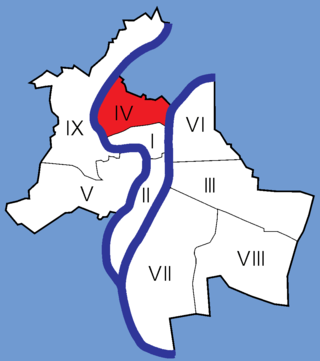
The 4th arrondissement of Lyon is one of the nine arrondissements of the City of Lyon.

The Place Ampère is a pedestrian square located in the Ainay square, in the 2nd arrondissement of Lyon. It is nearly the middle of the rue Victor-Hugo and is served by the metro station Ampère - Victor Hugo.

The Place Carnot is a square located in the Perrache quarter, in the 2nd arrondissement of Lyon.
The city of Lyon and its urban area have several parks. The main parks in the inner city include Jardin des Chartreux in the 1st arrondissement, Parc Bazin, Parc Chambovet and Parc Sisley in the 3rd arrondissement, Parc de la Cerisaie, Parc Francis Popy and Jardin Rosa Mir in the 4th arrondissement, Jardin des Curiosités, Parc de la garde and Parc des Hauteurs in the 5th arrondissement, Parc de la Tête d'or in the 6th arrondissement, Parc de Gerland, Parc des berges du Rhône and Parc Sergent Blandan in the 7th arrondissement, and Parc de Montpellas, Parc Montel and Parc du Vallon in the 9th arrondissement.

The Place Sathonay is a square located in the 1st arrondissement of Lyon, France, at the bottom of hill of La Croix-Rousse, in La Martinière quarter. It was named after Nicolas-Marie-Jean-Claude Fay de Sathonay, mayor of Lyon from 1805 to 1812, as a tribute for all the importants works undertaken under his presidency. The square is currently the third largest square in Lyon and belongs to the zone classified as World Heritage Site by UNESCO. According to Lyon geography agrégé Jean Pelletier, it is "one of the most interesting squares of Lyon", because of its harmonious proportions, its boundaries composed of buildings with beautiful 1920s facades, and its plantations, which brings "a charm tinged of poetry" and give it the appearance of a village square.
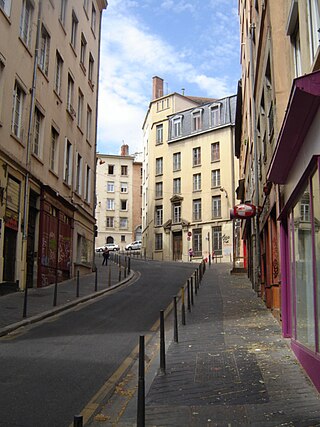
The Montée des Carmélites is one of the oldest streets of Lyon, dating from Roman times, located in the 1st arrondissement of Lyon. It connects the Saint-Vincent quarter to the Plateau de la Croix-Rousse. It is situated between the rue de la Tourette and the rue Ray Fernand, and ends at the intersection of the rue Burdeau, rue du Jardin des Plantes and rue de l'Annonciade.

The Rue Burdeau is a street located in the 1st arrondissement of Lyon, at the bottom of the slopes of La Croix-Rousse, just above the Église Saint-Polycarpe, between the Saône and the Rhône. It leads at one side to the Montée Saint-Sébastien and at the other to the Jardin des Plantes and crosses the montée de la Grande Côte which renovation is completed. The street belongs to the zone classified as World Heritage Site by UNESCO.

The Place Benoît-Crépu is a stone-paved square, located in Saint-Georges quarter, on the banks of the Saône, in the 5th arrondissement of Lyon. It has fountains with dolphin heads, many benches and trees and a playground. The place belongs to the area classified as World Heritage Site by UNESCO.
The Maison de la danse is a theater located in the 8th arrondissement of Lyon, France. It was founded in 1980 in the Théâtre de la Croix-Rousse before moving in 1992 in what was called the Théâtre du 8ème. This very important place for dance in the Rhône-Alpes region makes programming of international companies and of young companies of Rhône-Alpes. The building also hosts resident company in a creative studio and has a basic reference document on dance with a library composed of over 1,000 shows filmed.

The Gare des Brotteaux is an old railway station located in the Brotteaux quarter, in the 6th arrondissement of Lyon.

The Place Croix-Paquet is a square located in the 1st arrondissement of Lyon, in the pentes de la Croix-Rousse quarter. It is formed by the intersection of the rue du Griffon, the rue des Capucins and the montée Saint-Sébastien. The square belongs to the zone classified World Heritage Site by UNESCO.
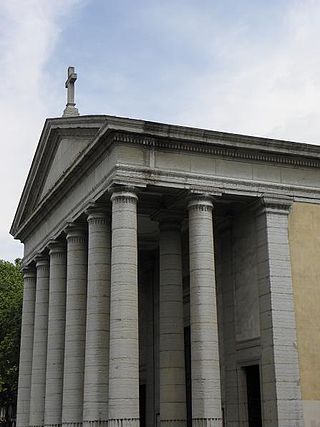
The Église Saint-Pothin is a Roman Catholic church located in Lyon, France. The parish church sits on the left bank of the Rhône, in the 6th arrondissement of Lyon, at the Place Edgar Quinet. By order of 2 May 2007, the whole church was included in the supplementary inventory of monuments historiques.

The parc de la Cerisaie is an urban park in the Croix-Rousse 4th arrondissement of Lyon, France. It is partially situated on a slope, leading from the plateau of the Croix-Rousse down towards the river Saône.
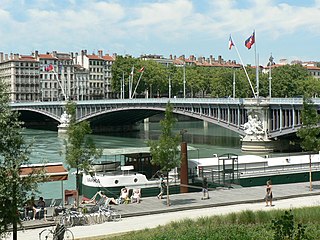
The Berges du Rhône or Quais du Rhône refer to a series of parks, quays, streets and walking paths along the Rhône river in Lyon, France. The construction for the modern Berges du Rhône took place between 2005 and 2007, resulting in the development of 10 hectares of land on the left and right banks of the Rhône from Parc de la Tête d'Or to Parc de Gerland.

Boulevard de la Croix-Rousse is a boulevard that marks the border between the 1st and the 4th arrondissements of Lyon, in the neighborhood Croix-Rousse.





















